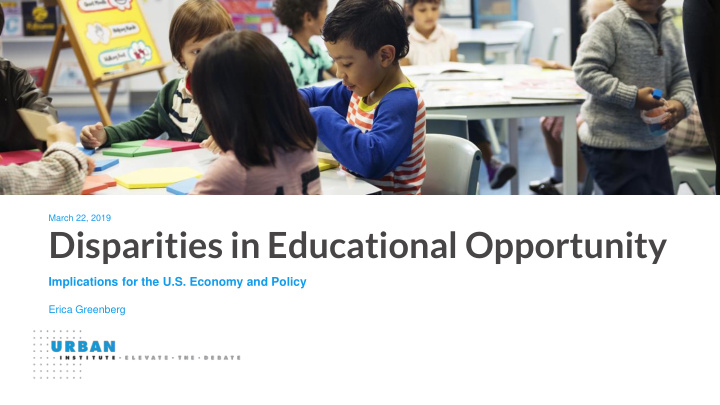



March 22, 2019 Disparities in Educational Opportunity Implications for the U.S. Economy and Policy Erica Greenberg
Definitions What is Educational Opportunity? ▪ Access to coordinated, excellent instruction that provides the skills all students will need to thrive in a rapidly changing economy and society (Duncan and Murnane 2014) ▪ Disparities by: race, ethnicity, nativity, socioeconomic status, gender, geography, etc. ▪ Challenges of observation: opportunity vs. outcomes 2
Good and Bad News History of Disparities in Educational Outcomes Growth in the Income- Based Test Score Gap Decline in the Black-White Test Score Gap Source: Sean Reardon, The Widening Income Achievement Gap, Educational Leadership 70(8), 10-16. Adapted from "The Widening Socioeconomic Status Achievement Gap: New Evidence and Possible Explanations" (p. 98) by S. F. Reardon, in R. J. Murnane & G. J. Duncan (Eds.), Whither Opportunity? Rising Inequality, Schools, and Children's Life Chances , 2011, New York: Russell Sage Foundation. 3
Origins When do Disparities in Educational Outcomes Arise? ▪ By 9 months – and disparities widen through 2 years (Halle et al. 2009) ▪ Preservation through school and growth into postsecondary education (Baker, Klasik, and Reardon 2018; Reardon 2013) 4
Origins What is Happening During Children’s Early Years? ▪ Substantial disparities in educational opportunity ▪ Among children 3-5, 71% of poor children versus 84% of non-poor children are read to regularly at home (NHES 2016) ▪ Among children 0-5, 46% of poor children versus 63% of non-poor children experience any regular early care and education (NHES 2016) ▪ Quality varies across settings (Bassok, Fitzpatrick, Greenberg, and Loeb 2016) ▪ Yet, gaps in early childhood experiences and in early school outcomes are narrowing (Bassok et al. 2016, Reardon and Portilla 2016) 5
Interpretation What, then, Can Schools and Other Institutions Do? ▪ Can schools ▪ Reverse early disparities? ▪ Hold inequality at bay? ▪ Perpetuate broader inequities? ▪ Disparities persist because of forces well beyond education. 6
Implications Longer-Term Implications for the U.S. Economy ▪ Lost human capital ▪ Economic inequality ▪ Global competitiveness 7
Early Childhood, Education, and Social Policies Policy Implications High-quality public programs like state prekindergarten and Head Start are closing gaps in access. ▪ Investments in evidence-based initiatives ▪ Young children ▪ Schools, colleges, and universities Source: Erica Greenberg, Victoria Rosenboom, and Gina Adams. Paper for US 2050. ▪ Health, housing, income supports ▪ Policy innovation paired with evaluation Source: Constance Lindsay and Victoria Lee. Which Colleges Are Helping Create a Diverse Teacher 8 Workforce? Urban Institute.
Addressing Disparities How Will We Know if Policies Are Working? The long-term measure of success will be the educational attainments and earnings of adults who grew up in low-income families and the restoration of intergenerational mobility. - Duncan and Murnane (2014) , Restoring Opportunity 9
Return to Opportunity Toward US 2050 The project’s goal is to foster a clearer vision of America’s future and spur a sense of urgency to address pressing policy concerns, thereby laying the groundwork for better outcomes. 10
Recommend
More recommend